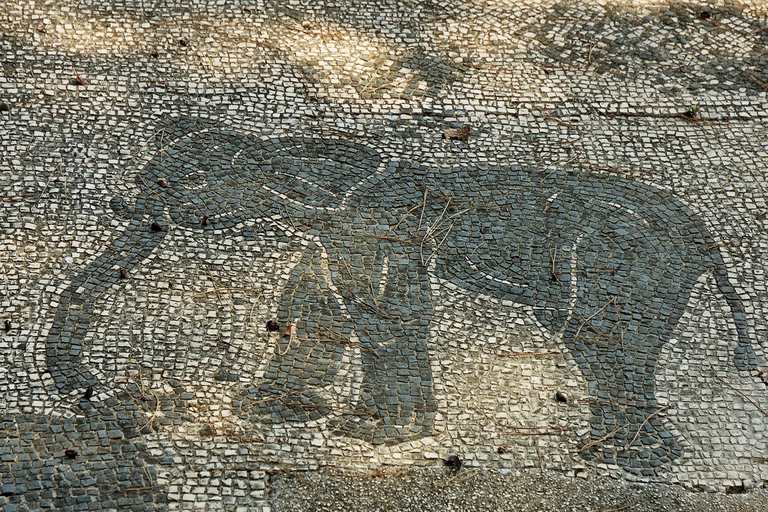Scholar Feature
This article first appeared in ISAW Newsletter 13, Fall 2015.
Claire Bubb
Visiting Assistant Professor
Galen of Pergamon describes a day in Rome in the middle of the second century A.D. on which he and many of his fellow doctors “thronged” to the dissection of a newly killed elephant. There, hands plunged into the gore, they hotly debated the ramifications of what they saw for the various anatomical theories that they supported. Galen’s description evokes a crowded, contentious, and blood-bespeckled scene, including not just the doctors but also some imperial cooks, who make away in the end with choice cuts of the meat.
 Mosaic with an elephant. Part of Statio 14 (for Sabratha office) of the Piazzale delle Corporazioni, Ostia Antica, Latium, Italy. © Marie-Lan Nguyen / Wikimedia Commons.
From as early as the 5th century B.C. the dissection of animals played an important role in the development and defense of Greek medical theories. Authors appeal to what can be seen in dissections as evidence for the claims that they are making about the workings of the human body. For a brief period in Hellenistic Alexandria, they even report the results of human dissections, which led to major leaps forward in anatomical and physiological knowledge. Galen is our main source for the practice of dissection in the Roman Empire, and he provides an abundance of colorful material on the subject, like the paragraph discussed above. Beyond just describing such scenes, he also offers instructions for how to recreate them, assuming that his readers will be as eager as he is to manipulate the viscera of dead animals in a quest for scientific understanding.
Mosaic with an elephant. Part of Statio 14 (for Sabratha office) of the Piazzale delle Corporazioni, Ostia Antica, Latium, Italy. © Marie-Lan Nguyen / Wikimedia Commons.
From as early as the 5th century B.C. the dissection of animals played an important role in the development and defense of Greek medical theories. Authors appeal to what can be seen in dissections as evidence for the claims that they are making about the workings of the human body. For a brief period in Hellenistic Alexandria, they even report the results of human dissections, which led to major leaps forward in anatomical and physiological knowledge. Galen is our main source for the practice of dissection in the Roman Empire, and he provides an abundance of colorful material on the subject, like the paragraph discussed above. Beyond just describing such scenes, he also offers instructions for how to recreate them, assuming that his readers will be as eager as he is to manipulate the viscera of dead animals in a quest for scientific understanding.
My current research is focused on the practices, attitudes, and agendas required for and revealed by the activity of dissection as practiced by Galen, those around him, and those who followed him. Not only did doctors attend the public dissection of animals, nonmedical individuals of various stripes could also be found there. He mentions audience members ranging from consuls to freedmen, from philosophers to women of wealth. This puts dissection at a unique crossroads between science and entertainment, and I consider the ways in which it intersects with both categories. On the one hand, the spectacle of some of the dissections must have been striking, especially when performed with the panache that Galen describes, and the procurement of the material needs, particularly the animals, would have led to overlap with other forms of entertainment. On the other hand, the intentions of the dissectors were far from frivolous, and Galen is urgent about the absolute necessity of anatomical skills for the furtherance of medical knowledge. I explore how the differing halves of this duality led to a variable history for the practice of Galenic dissection, ranging from near obsolescence in the 5th-10th centuries to a triumphant resurgence in the 16th century, when it sparked the beginning of the dissection practices still deployed in medical schools today.